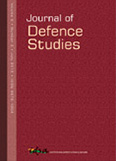Indian Aerospace Power
Modern aerospace power is the only instrument that would give the country an assured capability to project precision fire power at great distances with or without mid-air refuelling and AWACS support and therefore, continues to remain the best instrument for deterrence and instantaneous and calibrated response to emerging threats. Whatever India decides, it cannot but modernise its aerospace power.
- Ramesh Phadke |
- April 2010 |
- Journal of Defence Studies




